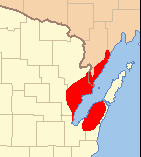Peshtigo Fire
| Peshtigo Fire | |
|---|---|

Extent of wildfire damage
|
|
| Location | Peshtigo, Wisconsin |
| Coordinates | 45°03′N 87°45′W / 45.05°N 87.75°WCoordinates: 45°03′N 87°45′W / 45.05°N 87.75°W |
| Statistics | |
| Date(s) | October 8, 1871 |
| Burned area | 1,200,000 acres (4,900 km2) |
| Cause | Small fires whipped up by high winds in dry conditions |
| Fatalities | 1500–2500 (estimated) |
| Map | |
The Peshtigo Fire was a forest fire that took place on October 8, 1871 in and around Peshtigo, Wisconsin. It was the deadliest wildfire in recorded history, with estimated deaths of around 1,500 people, possibly as many as 2,500.
Occurring on the same day as the more famous Great Chicago Fire, the Peshtigo Fire has been largely forgotten. On the same day as the Peshtigo and Chicago fires, Holland and Manistee, Michigan (across Lake Michigan from Peshtigo), and Port Huron at the southern end of Lake Huron also had major fires, leading to various theories of mutual cause by contemporaries and later historians.
The setting of small fires was a common way to clear forest land for farming and railroad construction. On the day of the Peshtigo Fire, a cold front moved in from the west, bringing strong winds that fanned the fires out of control and escalated them to massive proportions. A firestorm ensued. In the words of Gess and Lutz, in a firestorm "superheated flames of at least 2,000 degrees Fahrenheit...advance on winds of 110 miles per hour or stronger. The diameter of such a fire ranges from one thousand to ten thousand feet.... When a firestorm erupts in a forest, it is a blowup, nature's nuclear explosion...."
By the time it was over, 1,875 square miles (4,860 km² or 1.2 million acres) of forest had been consumed, an area approximately twice the size of Rhode Island. Some sources list 1.5 million acres (6,100 km²) burned. Twelve communities were destroyed.
An accurate death toll has never been determined because local records were destroyed in the fire. Between 1,200 and 2,500 people are thought to have lost their lives. The 1873 Report to the Wisconsin Legislature listed 1,182 names of deceased or missing residents. In 1870, the Town of Peshtigo had 1,749 residents. More than 350 bodies were buried in a mass grave, primarily because so many had died that no one remained alive who could identify all the bodies.
The fire jumped across the Peshtigo River and burned on both sides of the inlet town. Survivors reported that the firestorm generated a fire whirl (described as a tornado) that threw rail cars and houses into the air. Many escaped the flames by immersing themselves in the Peshtigo River, wells, or other nearby bodies of water. Some drowned while others succumbed to hypothermia in the frigid river. The Green Island Light was kept lit during the day because of the obscuring smoke, but the three-masted schooner George L. Newman was wrecked offshore, although the crew was rescued.
...
Wikipedia

